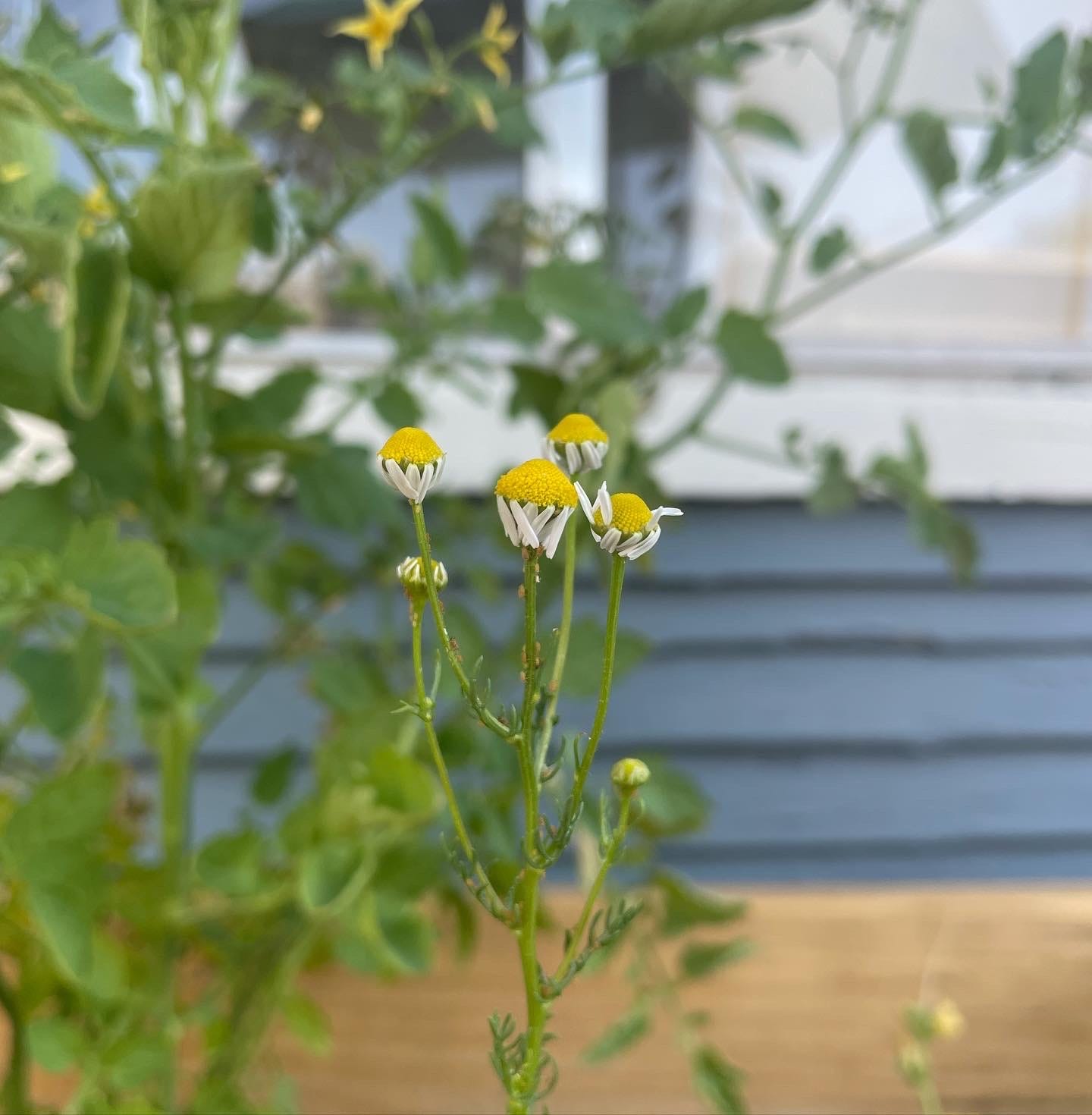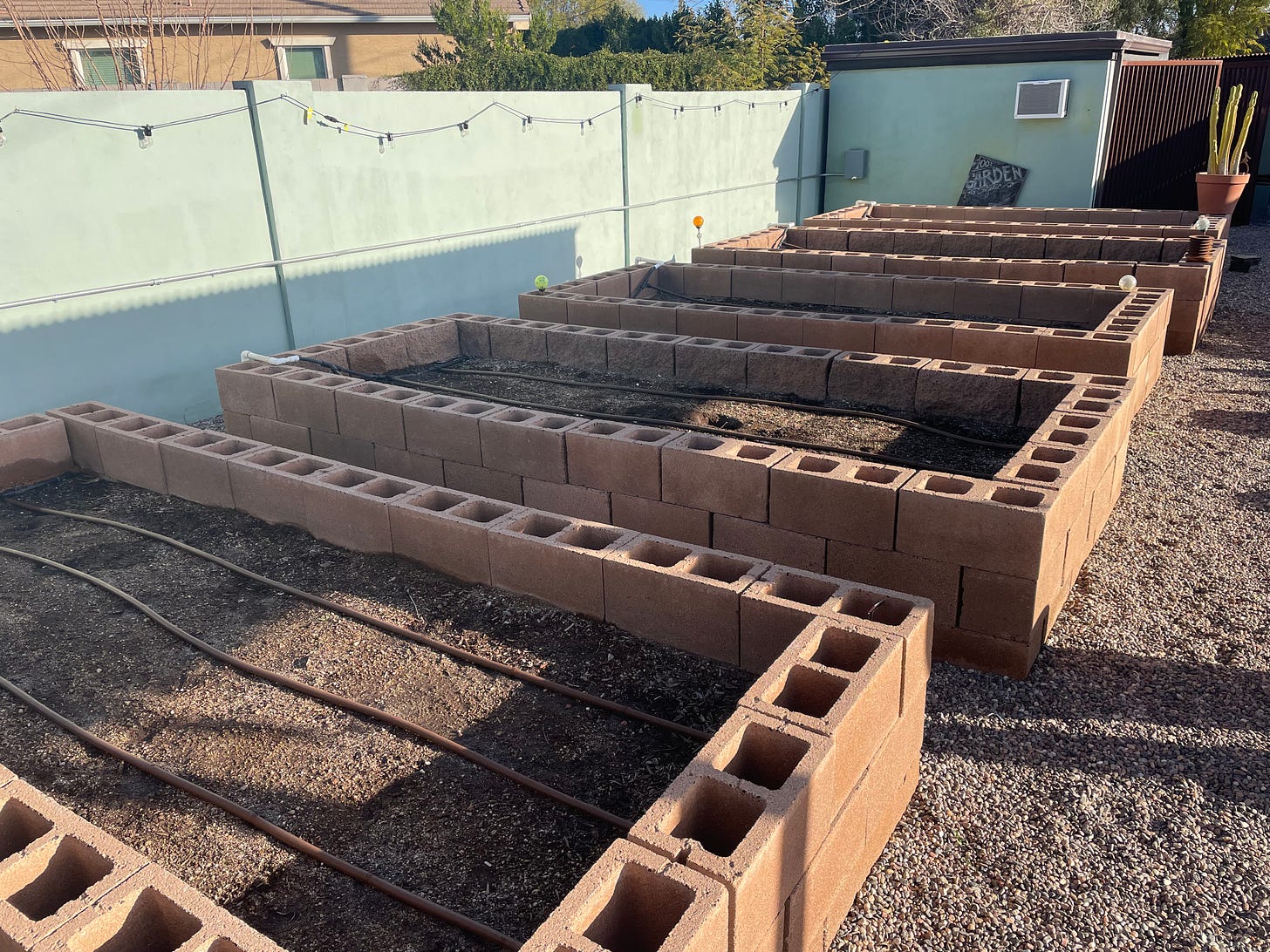Our Journey in Building a Home Garden
How we are planning to grow all of our own vegetables in the low desert
Ever since the pandemic hit, I’ve been wanting to grow my own food. It seemed like the world was spiraling out of control and there was little I could do to take care of myself. I didn’t want to feel like I had to rely on someone else. I wanted to know that I could survive on my own rather than depend on grocery stores for nourishment.
I started to wake up to how dangerous it was to depend on forces outside of myself for my own health and healing.
Back in the early 1900s, at least 50% of people grew their own food. This was when a majority of people were a healthy weight and spent their days outside. Now, we are obese, as sick as ever, and spend our time inside staring at a screen.
I’m a huge believer that this is due to giving away our power and putting our trust in an institution outside ourselves, separate from nature. Instead of letting the Earth heal us, we are dependent on packaged foods, drugs, and the recommendations of institutions sponsored by corporate greed.
Whatever happened to eating what we grow? To eating what’s in season? To using nature’s nature medicine (herbs) for our ailments?
I’ve already done an in-depth newsletter on the brokenness of our food chain, which I highly recommend you check out.
When we grow our own food, we don’t have to depend on a source outside ourselves for nourishment. We will never have to sacrifice our values in exchange for food. We can fully control what we are eating without the government stepping in.
It’s powerful to know you can take care of yourself and your family with the skills you’ve built. This is exactly what I aim to do throughout my gardening journey.
First Steps to Growing Our Own Food
Last year around this time, we were living in the heart of downtown Phoenix. We had a house and a small yard, which felt like a luxury to us city folks. I decided I finally had the space to start a small garden.
I bought a wooden raised bed from a local couple on Marketplace, who built it themselves (woodworking- another awesome skill to have!). I headed to my local garden store for soil and to pick out some transplants.
I had assumed that whatever transplants they had were what was appropriate to plant in May in the desert. That was my first lesson, which I now know is wrong.
I picked out some dark leafy greens, a tomato plant, dill, marigold, cilantro, lavender, chamomile, and cucumber. Pretty ambitious for one garden bed! Not to mention, these plants do not go well together at all.
Then I waited a few weeks to plant them in the bed because I was lazy. I also did not water them regularly. The poor plants were sitting underwatered in the hot desert sun in their transplant containers.
Eventually, I planted them in the bed. Honestly, most of them died pretty quickly. I had already set myself up for failure. The marigold quickly dried to a crisp in the hot sun. The dill withered away. The only plants standing after a few weeks were the cucumber, tomato, and chamomile.
Now looking back, I think the cucumber was never pollinated. There were flowers, and it was growing, but no fruit ever started. If you didn’t know, fruits have flowers that need to be pollinated before they can grow the fruit.
My tomato was thriving! I bought a cage to help support the fruit it was growing. Unfortunately, I was only able to enjoy a few cherry tomatoes before leaving for the summer (but they were some of the best I’ve ever had!). Note to self: plant tomatoes earlier so you can enjoy the fruits of their labor.
The chamomile also did very well. I had fun harvesting the flower heads at just the right time- when the white leaves open for the first time- and drying them. Because I only had one plant, I ended up with about 1 tbsp of dried chamomile. Just enough for one cup of tea.
Herbs will produce but you need a lot of them if you’re making teas!
The Beginning of Our Serious Gardening Journey
I tell you all of this because we all need to start somewhere. That was my starting point. If you live in a city, know that it’s possible to get started. You can make it work, you just need to be resourceful.
I also want to document my journey. Now, we live in a house in Pheonix with a huge yard and 6 above-ground beds. This is plenty of space to grow a garden that fully sustains our fruit and vegetable intake!
The above-ground bed downtown was a warm-up without much research. Now, I’m researching thoroughly because I want to do things right. We had our favorite woman from the farmer’s market come over and guide us on the next steps. I joined the Growing in the Garden Academy on Patreon to learn more about low-desert gardening. Sebastian also bought me her calendar so I know what to plant each month.
We are lucky to already have the raised beds and a watering system in place. These are some of the hardest parts of starting a garden. I don’t know about you but I wouldn’t be as thrilled to have to build beds and engineer a watering system. The exciting part is the planting, and we get to jump right into that!
Well, not quite. But almost.
Soil Testing
First, we had to test the soil that is already in the beds. Our real estate agent had originally told us that we would have to get rid of all the soil and replace it with new stuff. Luckily, when we had our consulting session, the gardener told us that the soil we have is great. We just need to get it tested to see what needs to be added to it.
We did our testing through ISA laborities if you are local to Phoenix.
They gave us scores for the following nutrients:
nitrogen
phosphate
sodium
calcium
And more…
They also give you the pH of your soil so you know whether you should make it more or less acidic. Luckily, our soil was right around 7- meaning it’s well-balanced.
Now, we need to add organic matter to our soil in order to balance all of these nutrients out. It’s a little chemistry game!
We are still debating on how to get these nutrients into the soil. Luckily, we have an amazing gardener who can offer us advice. This is why you make friends with the sellers at your local farmer’s market!
Crop Planning
Once we get the soil balanced, I will start planning what I want to plant and where. February is a great month for planting both cool and warm-season crops in the desert. I plan to plant a bit of both!
Gardening in the desert is a whole other game than gardening anywhere else. Luckily, there are tons of resources on which plants work in this climate. Our gardener gave us a book called “Desert Gardening for Beginners” which has been super helpful for learning about lower desert gardening.
Here are some varieties I really want to plant:
arugula
romaine
carrots
squash
basil
dill
tomatoes
chamomile
dandelion
meyer lemon
I’m trying to think about what I buy most often from the grocery store. That way, I can replace these weekly grocery trips with fresh pickings from my garden!
It’s important to have a list of coveted crops before planting them because of the planning ahead that is required. For example, some plants require more nitrogen or phosphorous than others. Some require part sun and part shade. These factors all determine where in the bed a crop should be planted, and what it should be planted with. This is something I never even considered with my first little city garden!
I’ll share more about what I’m planting and how I’m organizing the bed in an upcoming newsletter.
Conclusion
I already feel empowered taking the steps I am to control our own food source. It’s surprisingly an amazing feeling to be a complete beginner at something. I have nowhere to go but up!
I’ve already learned so much about gardening, specifically low-desert gardening, in the last few months. It’s been an amazing way to connect with the community around me and get outside. Who knew I would find weeding fun?
When we live in a digital age where most of our work or entertainment is tied to screens and being indoors, it’s rejuvenating to have an excuse to get outside and work with your hands. Humans are meant to get dirty, work hard, and be in the sun for most of the day. Find a hobby that forces you to do just this!
If you have any gardening tips for me, feel free to comment below. Or, if you are also starting a garden, I’d love to hear more about your why.
Take Action: How can you take your food into your own hands? Do you have space for s small raised bed, or maybe a few? Maybe you only have space for a small basil plant on your countertop. That’s ok. We all need to start somewhere. Where can you start?
Have a lovely Sunday!
Madison Mae
PS: Go Eagles 🦅







